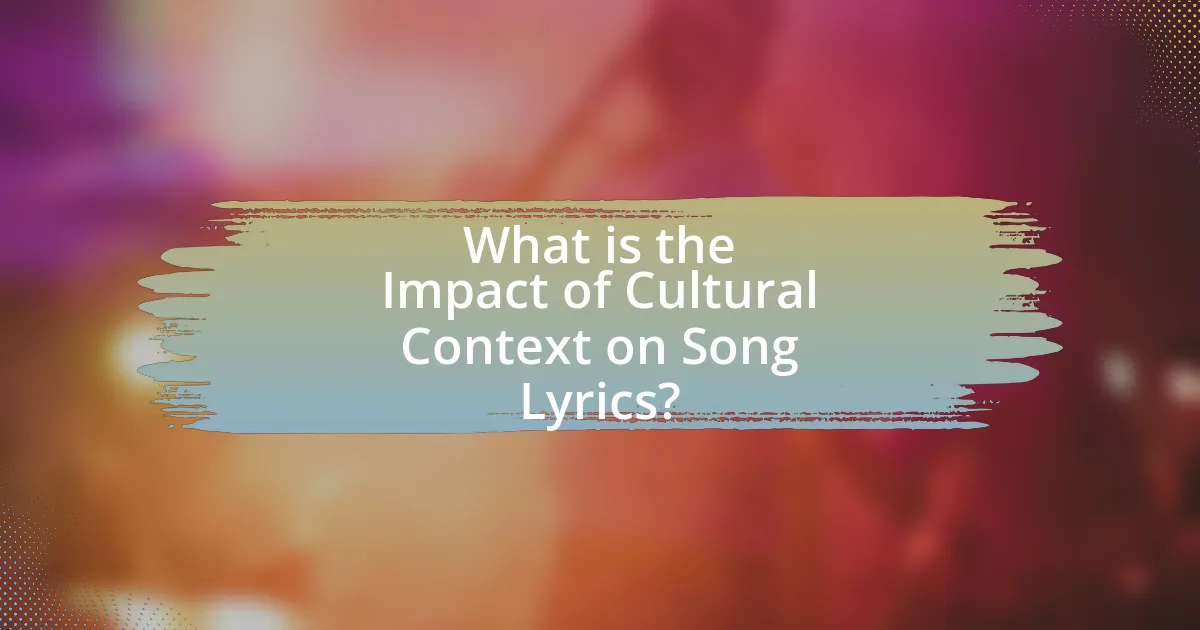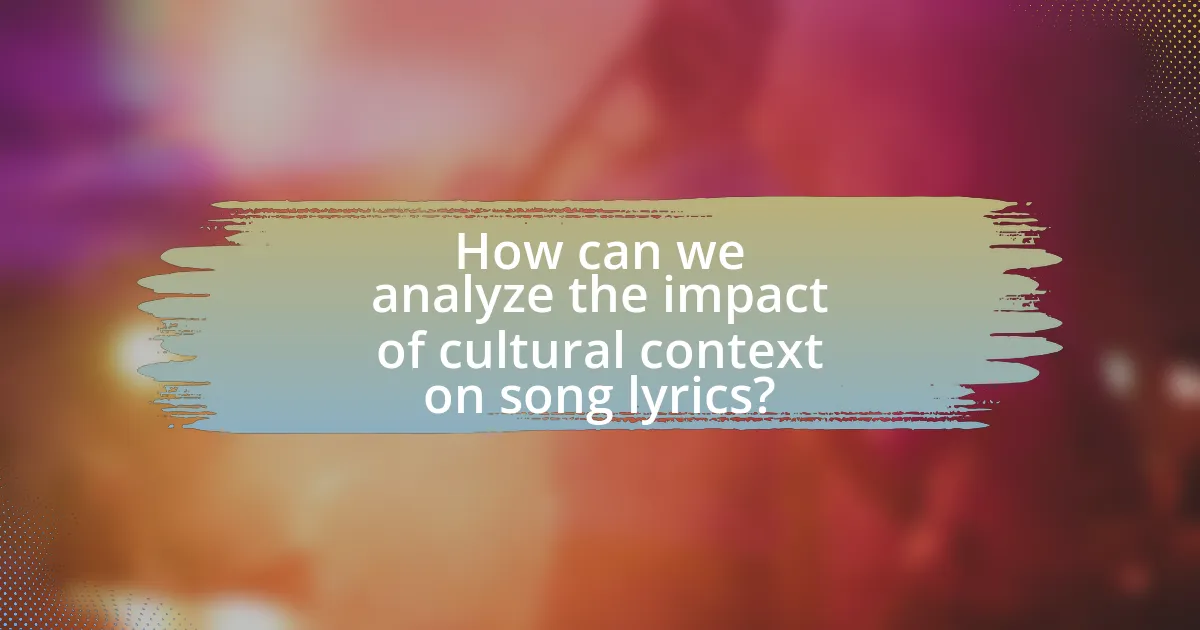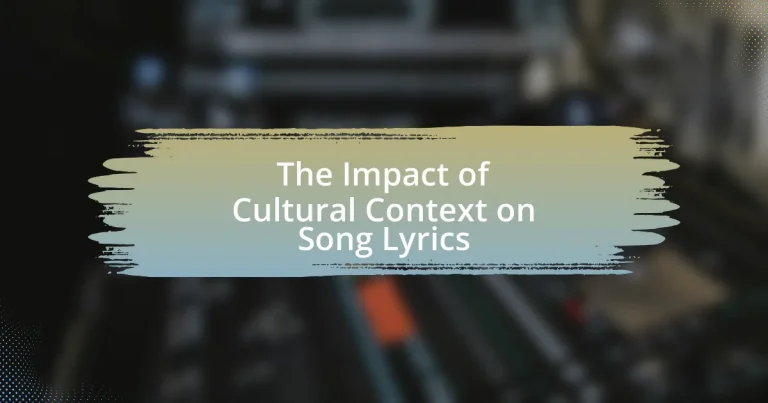The article examines the significant impact of cultural context on song lyrics, highlighting how themes, language, and emotional resonance are shaped by societal values, historical events, and cultural norms. It discusses the influence of cultural factors such as language, societal norms, and historical context on the content and interpretation of lyrics, providing examples from various genres that reflect cultural themes like love, social justice, and identity. Additionally, the article emphasizes the importance of understanding cultural context for interpreting song lyrics and explores how cultural misunderstandings can affect a song’s reception. It also outlines methods for analyzing the relationship between culture and lyrics, offering best practices for enhancing understanding of a song’s cultural background.

What is the Impact of Cultural Context on Song Lyrics?
Cultural context significantly influences song lyrics by shaping themes, language, and emotional resonance. For instance, songs often reflect societal values, historical events, and cultural norms, which can vary widely across different regions and communities. A study by the University of Southern California found that lyrics from various genres often incorporate local dialects and references that resonate with specific cultural experiences, enhancing relatability and emotional impact. This demonstrates that cultural context not only informs the content of song lyrics but also affects how audiences interpret and connect with the music.
How does cultural context influence the themes in song lyrics?
Cultural context significantly influences the themes in song lyrics by shaping the values, beliefs, and experiences that artists express. For instance, songs often reflect societal issues such as race, gender, and economic conditions, which vary across different cultures. A notable example is the civil rights movement in the United States, where artists like Sam Cooke in “A Change Is Gonna Come” used lyrics to address racial inequality, resonating deeply with the cultural struggles of the time. This connection between cultural context and lyrical themes demonstrates how artists draw from their environments to convey messages that reflect their realities and engage listeners on a personal level.
What are some examples of cultural themes reflected in popular songs?
Cultural themes reflected in popular songs include love, social justice, identity, and resilience. For instance, love is a prevalent theme in songs like “I Will Always Love You” by Whitney Houston, which explores deep emotional connections. Social justice is highlighted in “Fight the Power” by Public Enemy, addressing racial inequality and activism. Identity is examined in “Born This Way” by Lady Gaga, celebrating LGBTQ+ pride and self-acceptance. Resilience is captured in “Stronger” by Kanye West, emphasizing overcoming adversity. These examples illustrate how popular songs serve as a mirror to societal values and issues, resonating with listeners on multiple levels.
How do cultural values shape the messages conveyed in lyrics?
Cultural values significantly shape the messages conveyed in lyrics by influencing themes, language, and emotional expression. For instance, in societies that prioritize collectivism, lyrics often emphasize community, family, and shared experiences, reflecting the cultural importance of social harmony. Conversely, in individualistic cultures, lyrics may focus on personal freedom, self-expression, and individual struggles, showcasing the value placed on autonomy.
Research indicates that music often serves as a reflection of societal norms and values; for example, studies have shown that hip-hop lyrics frequently address issues of social justice and identity, resonating with the cultural experiences of marginalized communities. This connection between cultural values and lyrical content demonstrates how artists use their work to communicate relevant social messages, thereby reinforcing or challenging cultural narratives.
Why is understanding cultural context important for interpreting song lyrics?
Understanding cultural context is crucial for interpreting song lyrics because it provides insight into the themes, emotions, and messages conveyed by the artist. Cultural context encompasses the social, historical, and political background that influences the creation of music, allowing listeners to grasp nuances that may be lost without this knowledge. For instance, songs that reference specific events, traditions, or societal issues can carry meanings that resonate differently across cultures. An example is Bob Dylan’s “The Times They Are a-Changin’,” which reflects the social upheaval of the 1960s in America, making it essential for listeners to understand that era’s cultural dynamics to fully appreciate its significance.
How can cultural misunderstandings affect the reception of a song?
Cultural misunderstandings can significantly affect the reception of a song by altering listeners’ interpretations and emotional responses. When a song incorporates cultural references, idioms, or themes that are unfamiliar to a particular audience, it may lead to confusion or misinterpretation of the song’s intended message. For example, a study by the Journal of Cross-Cultural Psychology found that cultural context shapes emotional responses to music, indicating that listeners from different backgrounds may perceive the same song differently based on their cultural experiences. This can result in a song being appreciated in one culture while being criticized or overlooked in another, ultimately impacting its popularity and success across diverse audiences.
What role does cultural context play in the evolution of song lyrics over time?
Cultural context significantly influences the evolution of song lyrics over time by shaping themes, language, and societal messages. For instance, during the civil rights movement in the 1960s, artists like Bob Dylan and Nina Simone used their lyrics to address social justice and racial equality, reflecting the cultural upheaval of the era. Additionally, the rise of hip-hop in the 1980s and 1990s showcased the experiences of marginalized communities, with lyrics often addressing issues such as poverty, violence, and systemic racism, thus mirroring the cultural realities of those times. This interplay between cultural context and lyrical content demonstrates how societal changes, historical events, and collective sentiments directly inform the themes and expressions found in music, leading to a dynamic evolution of song lyrics that resonates with listeners across generations.

What are the different cultural factors that affect song lyrics?
Cultural factors that affect song lyrics include language, societal norms, historical context, religion, and regional influences. Language shapes the choice of words and expressions, impacting how emotions and stories are conveyed. Societal norms dictate what themes are acceptable or taboo, influencing the content and message of the lyrics. Historical context provides a backdrop that can inform the subject matter, as seen in protest songs that reflect social movements. Religion often influences lyrical themes, as artists may draw on spiritual beliefs or cultural traditions. Regional influences, such as local music styles and traditions, also shape the sound and lyrical content, as evidenced by the distinct characteristics of genres like country, hip-hop, and reggae.
How do historical events shape the lyrics of songs?
Historical events significantly shape the lyrics of songs by providing context and inspiration that reflect societal sentiments and experiences. For instance, songs like “Fortunate Son” by Creedence Clearwater Revival emerged during the Vietnam War, capturing the anti-war sentiment prevalent among the youth. Similarly, Bob Dylan’s “The Times They Are a-Changin'” was influenced by the civil rights movement and the social upheaval of the 1960s, resonating with the desire for change. These examples illustrate how artists draw from historical moments to convey messages, evoke emotions, and connect with listeners, making the lyrics a reflection of the cultural and political landscape of their time.
What are some notable songs that reflect historical events?
Notable songs that reflect historical events include “Fortunate Son” by Creedence Clearwater Revival, which critiques the Vietnam War and the class disparities in who was drafted. Another significant song is “The Times They Are a-Changin'” by Bob Dylan, which became an anthem for the civil rights movement and social change in the 1960s. “Zombie” by The Cranberries addresses the violence of the Troubles in Northern Ireland, specifically the 1993 Warrington bombings. Additionally, “American Idiot” by Green Day reflects the political climate and discontent during the early 2000s, particularly in response to the Iraq War. Each of these songs captures the essence of their respective historical contexts, making them powerful cultural artifacts.
How do artists use lyrics to comment on social issues?
Artists use lyrics to comment on social issues by incorporating themes, narratives, and language that reflect societal challenges and injustices. For instance, songs like “Fight the Power” by Public Enemy address racial inequality and systemic oppression, directly engaging listeners in social discourse. Additionally, artists often draw from personal experiences or historical events, as seen in Bob Dylan’s “The Times They Are a-Changin’,” which captures the spirit of the civil rights movement. This method not only raises awareness but also encourages activism, as evidenced by the widespread impact of songs during pivotal moments in history, such as the Vietnam War protests. Through their lyrics, artists effectively serve as cultural commentators, using their platform to influence public perception and inspire change.
What role does language play in the cultural context of song lyrics?
Language serves as a crucial medium for expressing cultural identity and values in song lyrics. It reflects the social, historical, and emotional contexts of a community, allowing artists to convey messages that resonate with their audience. For instance, the use of regional dialects or slang in lyrics can evoke a sense of belonging and authenticity, as seen in genres like hip-hop and folk music, where local vernacular enhances relatability and cultural pride. Additionally, language shapes the themes and narratives within songs, often addressing issues such as love, struggle, and social justice, which are deeply rooted in the cultural experiences of the artists and their communities. This interplay between language and culture not only enriches the lyrical content but also fosters a deeper connection between the artist and the listener, reinforcing the cultural significance of the music.
How does the choice of language influence the meaning of lyrics?
The choice of language significantly influences the meaning of lyrics by shaping the emotional resonance and cultural context of the song. Different languages carry unique connotations, idiomatic expressions, and cultural references that can alter the listener’s interpretation. For instance, a love song in Italian may evoke romantic imagery and passion due to the language’s melodic quality and cultural associations with romance, while the same lyrics translated into English might lose some of that emotional depth and cultural nuance. Studies, such as those by linguist Steven Pinker, indicate that language shapes thought and perception, reinforcing the idea that the linguistic medium affects how messages are received and understood.
What are the implications of translating song lyrics across cultures?
Translating song lyrics across cultures can lead to significant implications for meaning, emotional resonance, and cultural identity. The act of translation often alters the original intent and nuances of the lyrics, which can result in a loss of cultural references and emotional depth. For instance, idiomatic expressions or culturally specific themes may not have direct equivalents in the target language, leading to misinterpretations or diluted meanings. Research indicates that songs often encapsulate cultural values and social norms, and when these are translated, the essence of the original message may be compromised, affecting listeners’ connections to the music. Additionally, the reception of translated lyrics can vary widely among audiences, influencing their perception of the artist and the cultural context from which the song originates.

How can we analyze the impact of cultural context on song lyrics?
To analyze the impact of cultural context on song lyrics, one can examine the themes, language, and references within the lyrics in relation to the cultural background of the artist and the audience. For instance, songs often reflect societal issues, historical events, and cultural norms that resonate with listeners, such as Bob Dylan’s “The Times They Are a-Changin’,” which captures the spirit of the 1960s civil rights movement in the United States. Additionally, linguistic choices and idiomatic expressions in lyrics can reveal cultural nuances, as seen in the use of slang or regional dialects that connect with specific communities. By conducting a comparative analysis of lyrics across different cultures and time periods, researchers can uncover how cultural shifts influence artistic expression and audience reception.
What methods can be used to study the relationship between culture and lyrics?
Qualitative analysis, quantitative analysis, and comparative studies are effective methods to study the relationship between culture and lyrics. Qualitative analysis involves examining lyrical content through thematic analysis, which identifies cultural themes and symbols present in the lyrics. For example, researchers may analyze the lyrics of hip-hop songs to explore themes of identity and social justice, reflecting the cultural context of marginalized communities. Quantitative analysis can involve statistical methods to measure the frequency of cultural references in lyrics across different genres or time periods, providing insights into how cultural trends influence lyrical content. Comparative studies allow researchers to analyze lyrics from different cultures or regions, highlighting variations and similarities that reveal the impact of cultural context on songwriting. For instance, comparing folk songs from various countries can illustrate how cultural narratives shape lyrical themes.
How can lyrical analysis reveal cultural insights?
Lyrical analysis can reveal cultural insights by examining the themes, language, and context within song lyrics that reflect societal values and issues. For instance, songs often address topics such as love, identity, politics, and social justice, which can provide a window into the cultural climate of the time they were written. An example is the protest songs of the 1960s, like Bob Dylan’s “The Times They Are a-Changin’,” which encapsulated the civil rights movement and anti-war sentiments, illustrating how music can serve as a cultural barometer. Additionally, linguistic choices in lyrics, such as slang or dialect, can indicate regional identities and cultural nuances, further enriching our understanding of the cultural landscape.
What tools are available for analyzing song lyrics in cultural contexts?
Tools available for analyzing song lyrics in cultural contexts include qualitative analysis software, text mining tools, and cultural analytics platforms. Qualitative analysis software, such as NVivo and Atlas.ti, allows researchers to code and categorize lyrics to identify themes and cultural references. Text mining tools, like Voyant Tools and LIWC (Linguistic Inquiry and Word Count), enable the extraction of linguistic patterns and sentiment analysis, providing insights into the emotional and cultural significance of lyrics. Cultural analytics platforms, such as the Digital Humanities Toolkit, facilitate the visualization and interpretation of large datasets of song lyrics, helping to contextualize them within specific cultural frameworks. These tools collectively enhance the understanding of how cultural contexts influence the creation and reception of song lyrics.
What are some best practices for interpreting song lyrics within their cultural context?
Best practices for interpreting song lyrics within their cultural context include understanding the historical background of the song, analyzing the socio-political environment at the time of its creation, and recognizing the cultural references and symbols used in the lyrics. Historical background provides insight into the events or movements that may have influenced the artist, such as civil rights movements or significant cultural shifts. Analyzing the socio-political environment helps to contextualize the themes and messages conveyed in the lyrics, as many songs respond to or reflect societal issues. Recognizing cultural references and symbols is crucial, as they often carry specific meanings that resonate within particular communities or cultures, enhancing the listener’s understanding of the song’s intent and impact.
How can listeners enhance their understanding of a song’s cultural background?
Listeners can enhance their understanding of a song’s cultural background by researching the historical and social context in which the song was created. This involves exploring the artist’s background, the genre’s origins, and the cultural events that influenced the lyrics. For instance, understanding the civil rights movement can provide deeper insights into songs by artists like Bob Dylan or Nina Simone, whose works reflect the struggles and aspirations of that era. Additionally, examining the language, symbols, and references used in the song can reveal cultural nuances and meanings that are specific to a particular community or time period.
What resources are available for exploring the cultural significance of song lyrics?
Resources for exploring the cultural significance of song lyrics include academic journals, books, and online databases. Academic journals such as “Popular Music” and “Journal of Popular Music Studies” publish peer-reviewed articles that analyze the intersection of culture and music. Books like “Songs of Protest, War, and Peace: A Bibliography and Discography” by David C. King provide historical context and cultural analysis of specific songs. Online databases such as JSTOR and Google Scholar offer access to a wide range of scholarly articles and research papers focused on music and cultural studies. These resources collectively facilitate a deeper understanding of how song lyrics reflect and influence cultural narratives.





